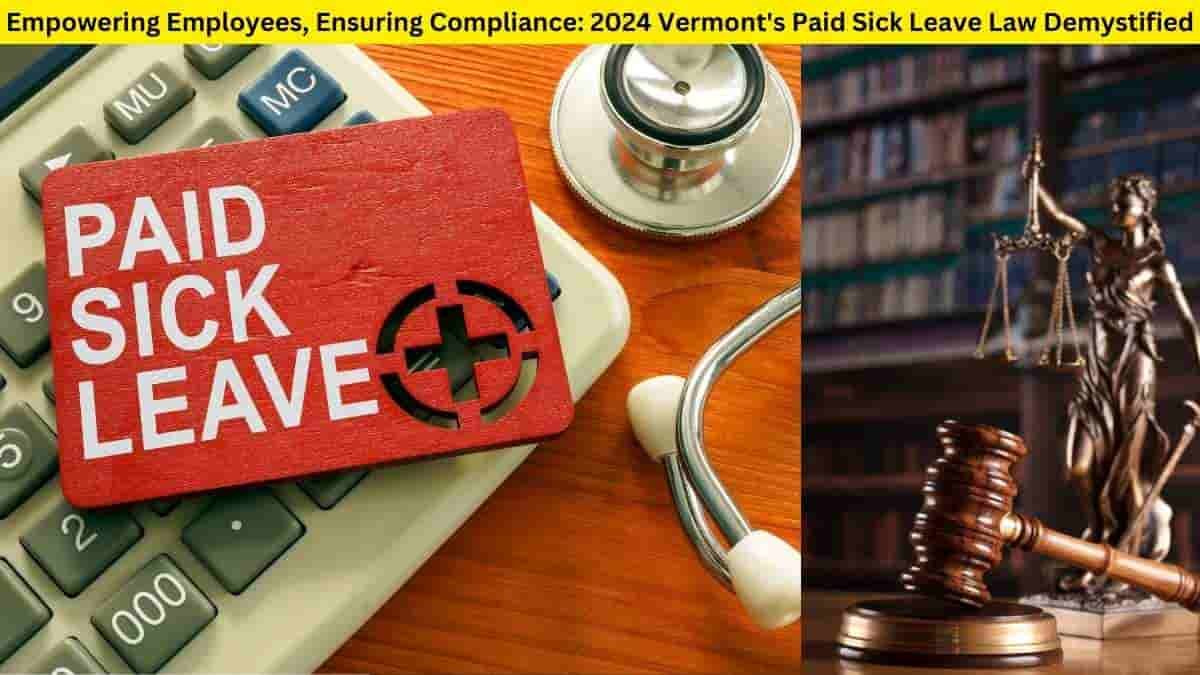
Vermont Paid Sick Leave Law: The Earned Sick Time (EST) statute in Vermont allows employees to take up to 24 hours of sick time during a two-year phase-in period. Employees will be eligible to accrue up to 40 hours of sick leave in a 12-month period starting on January 1, 2019. For every 52 hours worked, eligible employees are entitled to one hour of paid sick leave.
Workers receive compensation based on the number of hours they put in. Employees must be paid for sick time taken at their average hourly rate if their pay rate changes.
How do you receive paid sick leave in Vermont?
One advantage that not everyone enjoys is paid sick leave; over 24% of workers do not have access to it.
Workers must rely on state rules, while federal law only partially governs paid leave. Vermont is one of the fourteen states and the District of Columbia that have sick pay laws; employees in the other states must rely on their employer’s goodwill.
The Workings of Vermont’s Paid Sick Leave Law
The law’s goal is to set a minimum amount of paid leave that Vermont firms must provide to their employees.
Workers are entitled to 40 hours of paid leave per year, which is transferable to the following year if not used. One paid hour off is accrued for every 52 hours worked, including overtime. This is the pace of accrual.
In order to qualify for paid sick leave, workers must:
- Have attained the age of eighteen
- Work at least eighteen hours a week.
- Over 20 weeks of work during a 12-month period
- Not be a legitimate independent worker
Employees Who Are Covered (Vermont Paid Sick Leave Law)
All full-time and some part-time workers in Vermont are generally covered under the statute. The following are exempt from the law:
- workers for the federal government;
- workers for an employer for 20 weeks or less in a calendar year in a job planned to last 20 weeks or less in order to support or supplement the employer’s workforce in certain situations, such as employee absences, temporary skill shortages, seasonal workloads, and special assignments and projects;
- certain high-level workers for the state, such as those employed by the state legislature and courts;
- per diem or intermittently employed by health care facilities; and
- certain substitute teachers
- guest workers hired under a federal work visa programme or those exempt from the visa issuance process for specific reasons;
- independent contractors, sole proprietors, or partners in an unincorporated business exempt from the workers’ compensation provisions;
- employees who work an average of less than eighteen hours per week over the course of a year;
- workers under the age of eighteen
How Paid Sick Leave Is Used?
Earned sick leave can be utilised by staff members for the following reasons:
- The worker is unwell or hurt;
- The worker needs expert medical treatment for regular, preventative, therapeutic, or diagnostic purposes;
- The worker must provide care for a parent, grandparent, spouse, child, sibling, parent-in-law, grandchild, or foster kid, which may involve assisting the person in obtaining routine, preventive, therapeutic, or diagnostic medical attention;
- bringing a parent, grandparent, spouse, or parent-in-law along to a long-term care appointment;
- For themselves, their parent, grandparent, spouse, child, brother, sister, parent-in-law, grandchild, or foster child who is a victim of domestic abuse, sexual assault, or stalking, or who is relocating due to any of these circumstances, the employee must make arrangements for social or legal services, obtain medical attention, or seek counselling;
- The worker is required to provide care for a parent, grandparent, spouse, kid, brother, sister, parent-in-law, grandchild, or foster child because the establishment or school where the worker typically spends their working hours is closed due to public health or safety concerns.
Leave for Family Medical
Employees are protected by federal and state labor laws in Vermont. Vermont employers are subject to the federal Family and Medical Leave Act (FMLA), much as companies in other states. Furthermore, the state provides its workers with more medical leave options.
The Family and Medical Leave Act, which operates at the federal level, offers workers 12 weeks of unpaid leave every 12 months. If the employee continues to meet the eligibility requirements, this leave form is renewable every 12 months.
The following are the prerequisites for eligibility under the Family and Medical Leave Act:
- Workers have to be with their employer for a minimum of a year.
- Workers had to put in at least 1250 hours the year before.
Employees may be entitled to 12 weeks of leave under the FMLA when taking medical leave in the following situations:
- recuperating from a critical illness
- helping a family member recover from a medical condition
- taking care of a wounded or sick military family member
- forming a bond with a newborn
Official Documents of Vermont Paid Sick Leave
FAQ
Does Vermont have a paid sick leave law?
Yes, Vermont has a paid sick leave law. The law in Vermont allows workers to take up to 24 hours of paid leave annually in 2017 and 2018 and 40 hours after January 1, 2019, depending on their work hours. It really benefits employees by allowing them to stay focused on work.
Does Vermont have paid leave?
The State of Vermont has chosen Hartford to offer paid family and medical leave to state government workers starting July 1, 2023. Beginning July 1, 2024, Vermont private sector employers and other non-state government public employers can choose whether to offer coverage.